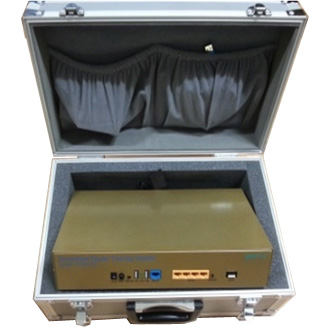Model No. CST-400
1. Features
This system provides users Embedded Programming Training on internet environment.
1) Learn the concept of network using all sorts of TCP/IP & applying protocols and managing systems.
2) Learn Embedded programming practice of TCP / IP protocol suite.
3) TCP / IP protocol analysis.
4) Gain skills about how to use a network system
5) Gain practical experience about the concept required for understanding and managing network basics including embedded Linux porting.
6) Understand basics of the Internet, TCP/IP architecture and protocols.
7) Ideal for learning the concept of networks, firewall system configuration, router (RIP, OSPF) configuration, web server configuration, VPN practice by using IPSec, or Intrusion Detection System (IDS).
8) Embedded program porting practice.
9) Practice for Embedded Programming Application.
10) Router 310 is to learn about OpenWRT based routers development, one of the most excellent embedded OS platforms for network equipment.
11) Users can learn about the target firmware programming to develop a router device as well as the routing protocols RIP, OSPF implementation.
12) It is a training equipment for users to develop a variety of high-end network applications,such as IDS, VPN, IoT(Internet of Things), Smart gateway which is recently & rapidly being emerged.
2. System configuration

3. Training contents
Chapter 1. Concept of Network
1.1 OSI reference model
1.1.1 Encapsuling OSI 7 layer
1.2 Ethernet(Ethernet)
1.2.1 CSMA/CD (Carrier Sense Multiple Access/Collision Detect)
1.2.2 Encapsuling Ethernet
1.3 TCP/IP
1.3.1 Understanding IP (Internet Protocol)
1.3.2 Understanding TCP (Transmission Control Protocol)
1.4 Network System
1.4.1 Hub
1.4.2 Repeater
1.4.3 Bridge
1.4.4 Multiplexing
1.4.5 Router
1.4.6 Gateway
Chapter 2. Understanding Practice Environment
2.1 Architecture of Cyber security-4.0
2.1.1 Specification
2.1.2 Cyber security-4.0 kit
2.2 Hardware interface
2.2.1 JTAG (Joint Test Access Group)
2.2.2 Serial cable
2.2.3 Ethernet cable
2.2.4. Hardware information
2.3 Software interface
Chapter 3. Practicing Embedded Linux Porting
3.1 Embedded system
3.1.1 What is embedded system?
3.1.2 Embedded system operating system
3.2 Linux
3.2.1 What is Linux?
3.2.2 Features of Linux
3.2.3 Linux architecture
3.3 Preparations for practice
3.3.1 OpenWRT
3.3.2 Practice room for OpenWRT development environment
3.3.3 Installing development environment
3.3.4 Building and uploading target
3.5 Review/Report
Chapter 4. Building Firewall
4.1 Objective of Practice and Concept
4.1.1 Firewall
4.1.2 Types of firewall
4.2 Preparations for practice
4.3 Practice environment
4.4 Sequence of practice
4.4.1 Compiling kernel
4.4.2 Placing in iptables RAMdisk
4.4.3 Practicing firewall
4.5 Review/Report
Chapter 5. Making Router
5.1 Objective of practice and concept
5.1.1 Router
5.1.2 RIP
5.1.3 OSPF (Open Shortest Path First Protocol)
5.1.4 Zebra
5.2 Preparations for practice
5.3 Practice environment
5.4 Sequence of practice
5.4.1 Cross-compiling
5.4.2 Sending Zebra to Cyber security-4.0
5.4.3 Setting up Zebra
5.4.4 Setting up ripd.conf file
5.4.5 Setting up ospfd.conf file
5.4.6 Setting up PC-2 and PC-3
5.4.7 Practicing ripd
5.4.8 Practicing ospfd
5.5 Review/Report
Chapter 6. Practice for Network Programming
6.1 Practice for ping Programming
6.2 Practice for arping Programming
6.3 Practice for tftpd Programming
Chapter 7. Building Web Server
7.1 Objective of practice and concept
7.1.1 What is web server?
7.1.2 What is HTML?
7.1.3 HTTP
7.1.4 Process of operating HTTP
7.1.5 HTTP message format
7.2 Preparations for practice
7.3 Practice environment
7.4 Sequence of practice
7.4.1 Cross-compiling
7.4.2 Sending web server to Cyber security-4.0
7.4.3 Setting up web server
7.4.4 Testing web server
7.5 Review/Report
Chapter 8. Building VPN by Using SSL
8.1 Objective of practice and concept
8.1.1 AH protocol
8.1.2 ESP protocol
8.1.3 Key management
8.1.4 IPSec VPN and SSL VPN
8.2 Preparations for practice
8.3 Practice environment
8.4 Steps of practice
8.4.1 OpenVPN kernel configuration and cross-compilation
8.4.2 Compiling OpenVPN and passing to Cyber security-4.0
8.4.3 OpenVPN Setup and Exercise
8.5 Review/Report
Chapter 9. Building Intrusion Detection System (IDS)
9.1 Objective of practice and concept
9.1.1 Misuse IDS
9.1.2 Anomaly IDS
9.1.3 Intrusion type
9.1.4 Network attack technique
9.2 Preparations for practice
9.3 Practice environment
9.4 Sequence of practice
9.4.1 Installing A.P.M.
9.4.2 Installing libpcap library
9.4.3 Installing IDS
9.4.4 Setting up IDS
9.4.5 Setting up MySQL
9.4.6 Installing log analysis tool
9.5 Review/Report
APPENDIX A - Ethereal
1. Installing Ethereal
1.1 Installing Ethereal
1.2 Packet filtering
APPENDIX B - vi editor
1. vi Introduction
1.1 Execution, end and saving file
1.2 Text entry
1.3 Cursor movement
1.4 Text change
1.5 Text deletion
1.6 Text copy
1.7 Others
2. vi Intermediate level user
2.1 Screen movement
2.2 Marking
2.3 Using multi-buffer
2.4 Pattern search and replacement
2.5 Executing Unix/Linux in vi
2.6 Ex mode
3. vi High-level user
3.1 Using idiom
APPENDIX C - JTAG
1. JTAG (Joint Test Access Group)
2. Architecture of boundary scan
APPENDIX D - Port No.
APPENDIX E – Acronyms
APPENDIX F – RFC (Request for Comments)
1. HTTP (Hyper Text Transfer Protocol)
2. IPsec (Internet Protocol Security)
3. RIP (Route Information Protocol)
4. OSPF (Open Shortest Path First)
5. NAT (Network Address Translation)
4. Specifications
1) Cyber security-4.0 hardware 2 pcs
2) Ethernet cable 4 pcs
3) USB3.0 AM/AF 1.0M Cable 2 pcs
4) Textbook 2 books
5) Program CD 1 pc
6) Power Adapter (12.0V, 2.0A) 2 pcs
7) Hardware spec
(1) CPU MIPS74Kc@720 MHz
(2) RAM 128MBytes
(3) Boot Flash 512KBytes
(4) User Flash 16MBytes
(5) Ethernet 10/100/1000Base-T, WAN - 1 port
10/100/1000Base-T, LAN - 1 port (Switch - 4 ports)
(6) WIFI 802.11ac
(7) USB USB2.0 2 pcs
(8) Reset Switch 1 pc
(9) LEDs Power, RUN, Ethernet status
(10) Power port 1 pc
(11) On/Off Switch 1 pc
(12) USB Port 1 pc
(13) USN LED 1 pc
(14) Console port 1 pc
8) Software spec
(1) OpenWRT DDK (Ubuntu on VirtualBox Image)
: Vbox,
: Vbox.1.2.3,
: VBoxStartup
(2) Open sources of Zebra (RIP, OSPF)
(3) Open sources of IDS(snort, libpcap)
(4) Open sources of VPN(OpenVPN, IPSec)
(5) Open sources of iptables, http